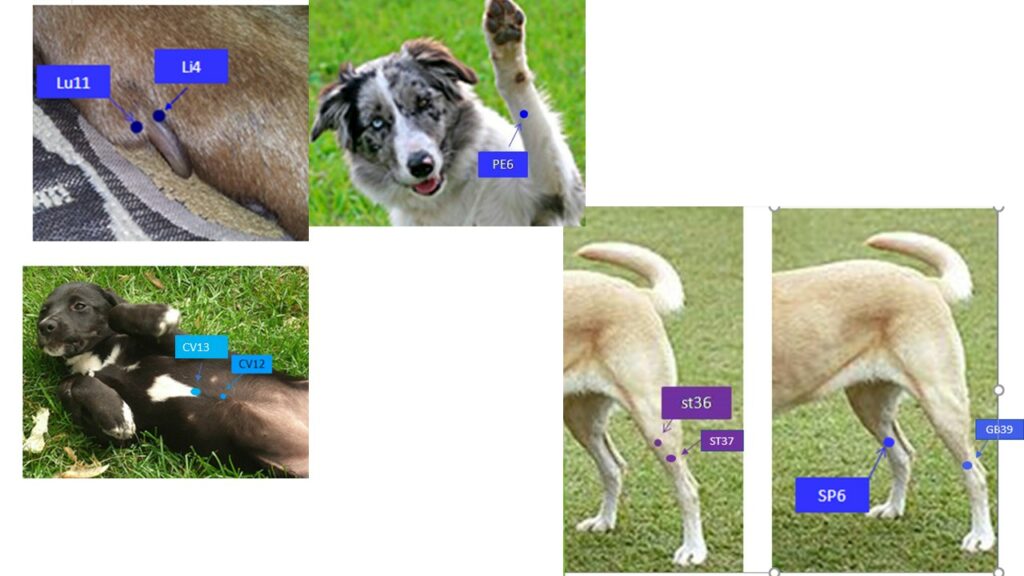
If your pet has had Acute pancreatitis you know it is very serious and requires medical intervention. Usually there are triggers that can escalate the onset and/or chronic condition. Cooked fatty foods, certain surgical procedures, certain drugs, processed food AKA kibble and genetics, also diabetes and obesity can play a role as well.
There are many things you as pet parent can do to manage or ideally prevent this. There are two articles and links below as well as some acu points that may help.
Here are some of the causes of Pancreatitis ?
According to veterinary journal dvm360, about 25 percent of dogs with acute diabetes also have acute pancreatitis.2 The condition is also more common in dogs who have had recent surgery, especially procedures involving the abdominal cavity. In addition, certain drugs are also suspected of triggering acute pancreatitis, including anti-seizure drugs such as potassium bromide or phenobarbital, prednisone and other catabolic steroids, and even the diuretic Lasix. Any dog can develop pancreatitis, but several small breed dogs are predisposed, including the Miniature Schnauzer, Cavalier King Charles Spaniel, Cocker Spaniel, Sheltie, Toy Poodle and the Yorkshire Terrier.
So what is a pancreas and what does it do. Here is a good description from Dogs Naturally Magazine
What’s The Pancreas?
The pancreas is a tiny gland that has a big job. It’s located just below your dog’s stomach and is attached to his small intestine. It’s part of both the endocrine system and the digestive system.
The pancreas has 2 major functions:
- Produce and store hormones (insulin and glucagon) to help maintain proper blood sugar levels.
- Produce and store enzymes (trypsin and chymotrypsin) to help the body digest protein and fats.
When the pancreas is under attack, the result is pancreatitis. Pancreatitis is a serious condition and it needs to be treated carefully and as soon as you have a diagnosis from your vet. If pancreatitis goes untreated, pancreatic enzymes can leak into the abdominal cavity, damaging the abdominal lining and other organs like the kidney and liver. As well as digest itself which is a big problem
How To Tell If Your Dog Has Pancreatitis
Dog pancreatitis can either be acute or chronic. Both can have symptoms ranging from mild to severe.
Acute Dog Pancreatitis
This is an attack of pancreatitis that comes on suddenly, usually with no history of the condition. Often these attacks come around the holidays when dogs are more likely to get into food that is very fatty, either from the garbage or from overly-eager feeders of table scraps. Stressful changes to regular routine, such as boarding at a kennel, having company or family members going away or extra commotion and visitors over the holidays, can also cause acute attacks. These tend to be the more serious of the two.
Chronic Dog Pancreatitis
Chronic pancreatitis develops over time, more slowly than acute. What makes chronic pancreatitis even more of a problem is that the symptoms are less obvious – you may not even see symptoms at all. Often dogs develop chronic pancreatitis after repeated acute attacks.
Symptoms Of Pancreatitis:
- Loss of appetite
- Diarrhea and vomiting
- Lethargy
- Dehydration
- Pain in the abdominal area
- Difficulty breathing
- Back pain
- Restlessness
- Arched back
For the full article click on the link https://www.dogsnaturallymagazine.com/dog-pancreatitis-11-steps-for-natural-healing/
This is also great info from Dr Karen Becker
Treatment Options and Prognosis for Dogs With Pancreatitis
There is no procedure or medication that cures pancreatitis, so treatment is supportive, with the goal of reducing the dog’s symptoms. Supportive therapy includes:
- Intravenous (IV) fluids to address dehydration, hypovolemia (decreased blood volume) and electrolyte imbalances
- Pain management
- Antiemetics to alleviate nausea and vomiting
- Enteral nutrition (tube feeding)
In most cases of pancreatitis, antibiotics are unnecessary and unhelpful. In addition, nonsteroidal anti-inflammatory drugs (NSAIDs) and steroid medications like prednisone should be avoided.
Dogs who suffer an acute bout of pancreatitis can have different outcomes. Some recover fully with no further issues, some recover but go on to suffer from chronic pancreatitis, and some dogs have recurrences of acute pancreatitis. In dogs with coexisting conditions such as diabetes, successful treatment of pancreatitis depends on successful treatment or management of other diseases.
Preventing Pancreatitis (or Its Recurrence)
Veterinarians are seeing increasing numbers of both dogs and cats with pancreatitis, and I’m convinced processed pet food plays a big role. High-carbohydrate diets affect insulin levels, which affect the pancreas.
KetoPet Sanctuary has made some interesting discoveries about dogs consuming unadulterated (raw) fat versus dogs eating cooked (processed) fat, in that raw fat (even very high-fat diets) did not cause pancreatitis in their cohort of patients, but cooked fat did induce pancreatitis in some patients, even in small amounts.
So the question we should be asking is, do the highly processed, poor-quality fats (heated repeatedly, up to four times during the manufacturing process before “pet food” is created) contribute to the epidemic of chronic, low-grade pancreatitis occurring worldwide in pets? I’m suspicious.
In addition, processed pet food is devoid of natural enzymes that help reduce pancreatic stress, which is why I suspect the pancreas of many pets exists in a state of chronic, low-grade inflammation. Food that doesn’t contain natural enzymes triggers the pancreas to try to make up the difference. If it fails to perform adequately, pancreatitis results. In addition, many pets are fed high-fat diets, which we know are a cause of pancreatitis.
Dogs (and cats) are designed to get supplemental enzymes from the foods they consume, since their ancestral diet is loaded with living foods that contain abundant enzymes. In the wild, dogs consume portions of the GI tracts of their prey, which is a rich source of enzymes. They also consume the glands, including pancreatic tissue, which are abundant in naturally occurring enzymes.
Even if you’re a raw feeder, chances are you aren’t giving your dog the stomach contents of prey animals, since this is where parasites reside. What this means is that even pets consuming a nutritionally balanced, species-appropriate raw food diet can be enzyme deficient.
One of the most important steps you can take to lower your dog’s risk of a repeat episode of pancreatitis is to provide a rich source of digestive enzymes, either through feeding pancreatic tissue (which is unappealing to most pet parents, and can be difficult to source) or a supplement. This will help reduce the stress your pet’s pancreas is under to produce enough enzymes to process food.
So if you have a dog who’s currently dealing with pancreatitis, has had it in the past or if you want to take preventive measures to reduce the likelihood your pet will develop the condition, adding digestive enzymes to his food that contains no cooked or processed fat at mealtime is a great way to help reduce pancreatic stress.
For full article click here https://healthypets.mercola.com/sites/healthypets/archive/2018/08/15/canine-pancreatitis.aspx
Below are a few points that may help manage symptoms or hopefully prevent future attacks along with help from your integrative vet . Also here is the study https://trialsjournal.biomedcentral.com/articles/10.1186/s13063-018-2644-1
LI4 /Lu11 is on either side of the dew claw of the front paw
PE6 Inside of the front limb between the tendons two finger widths above the crease in the wrist (transverse carpal crease)
CV12 On the ventral midline half-way between the xyphoid process
CV13 On the ventral midline 1 cun above CV12
ST 36 find the front of the knee and slide your finger down into the little groove on the lateral side of each knee
ST37 3 cun distal (below) St 36
Sp6 3 cun above the medial malleolus or ankle bone this point is on the bone so just follow it up two finger widths on the inside of the back leg.
GB39 3 cun above the tip of the lateral malleolus on the lateral side of the hind limb at the level of SP6
Cun “small measurement” the find the distance between the wrist and the elbow put your finger there; half that distance half it again and half it again, The distance between your finger and the wrist is 1 cun so it will be a personal measurement for each animal
